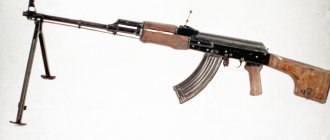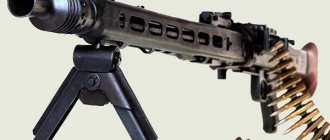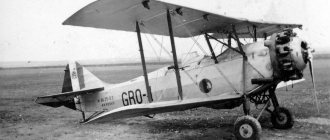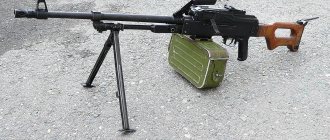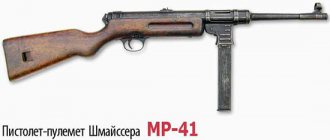This term has other meanings, see.
| MG 131 | |
| Type: | aircraft machine gun |
| A country: | Third Reich |
| Service history | |
| Wars and conflicts: | The Second World War |
| Production history | |
| Designed by: | 1933 — 1938[1] |
| Manufacturer: | Rheinmetall AG |
| Years of production: | since 1938[2] |
| Characteristics | |
| Weight, kg: | 16,6[2] |
| Length, mm: | 1168[2] |
| Barrel length, mm: | 533[2] |
| Cartridge: | 13×64 mm[2] |
| Caliber, mm: | 13 |
| Work principles: | recoil of the barrel during its short stroke |
| Rate of fire, rounds/min: | 900 |
| Initial bullet speed, m/s: | ~ 750[2] |
| Sighting range, m: | 1800 |
| Maximum range, m: | up to 2000[2] |
| Type of ammunition: | cartridge strip[2] |
MG 131MG 131
MG 131
- a large-caliber German aircraft machine gun from the Second World War.
Developed by Rheinmetall AG, mass production began in early 1938[2].
Installed on the Messerschmitt Bf 109, starting with the BF-109G model, Messerschmitt Me.410 Hornisse, Focke-Wulf Fw-190, Junkers Ju 88, He 177 and many other Luftwaffe aircraft.
Options and modifications
- MG 131 aviation machine gun
- produced in turret, wing and synchronous versions[1]. - infantry machine gun MG 131
- equipped with a bipod and a shoulder rest[1]. Due to the strong recoil, firing in short bursts was more effective than continuous fire[2] - MG 131Z
- coaxial machine gun mount - Naval Type 2 aviation machine gun
- the MG-131 version, produced under license in Japan during the Second World War, did not have significant differences from the original.
Links[edit]
- "Kurzbeschreibung Focke-Wulf Ta 400 Fernkampfflugzeug - Heckstand" (PDF). deutscheluftwaffe.de
. Focke-Wulf Flugzeugbau, Bremen. October 13, 1943 p. 11. Archived from the original (PDF) on August 24, 2015. Retrieved January 3, 2016. - Handbuch der Flugzeug Bordwaffenmunition 1936 - 1945 p.6
- ↑
MG 131 Waffen-Handbuch, September 1941, page 17 - Handbuch der Flugzeug Bordwaffenmunition 1936 - 1945 p.7
Notes
- ↑ 1234
13.2-mm aircraft machine gun MG.131 E1 // “Weapons” magazine, No. 1, 2005 (special issue “Infantry weapons of the Third Reich. Part VII. Machine guns”) p.48-49 - ↑ 1234567891011
Machine gun MG 131 // V. A. Kashevsky. Infantry weapons of the Second World War. Minsk, Harvest LLC, 2004. p.258-259 - “ in the units storming Breslau, political agencies spread the experience of using the captured heavy machine gun MG-131
” Lieutenant Colonel I. Ovcharov. Some issues of party-political work during the storming of fortified cities in the Vistula-Oder operation // Military Historical Journal, No. 3, 1972. pp. 80-85
Technical data [edit]
- Weight: 16.6 kg (37 lb)
- Length: 1.17 meters (3.8 feet)
- Muzzle velocity: ~750 meters per second (2500 ft/s)
- Rate of fire: ~900 rounds per minute.
13 mm MG 131 20 mm MG 151-20 ammunition Keski-Suomen ilmailumuseo
- 13 mm AP-T (Pzgr. L'Spur) - 710 m/s, projectile weight 38.5 g (594 g), muzzle energy 989 m/kg [2]
- 13 mm HE-T (Sprgr. L'Spur) - 710 m/s, projectile weight 34 grams (520 g) [3]
- 13 mm HEI-T (Br. Sprgr. L'Spur) - 750 m/s, projectile weight 34 g (520 g) with 1.4 g (22 g) heating element + 0.3 g (4.6 g) thermite , muzzle energy 975 m/s. kg [4]
Excerpt describing MG 131
The chief of artillery of the 3rd Corps, General Fouche, will place all the howitzers of the 3rd and 8th Corps, 16 in total, on the flanks of the battery, which is assigned to bombard the left fortification, which will total 40 guns against it. General Sorbier must be ready, at the first order, to march with all the howitzers of the Guards artillery against one or another fortification. Continuing the cannonade, Prince Poniatowski will head towards the village, into the forest and bypass the enemy position. General Compan will move through the forest to take possession of the first fortification. Upon entering the battle in this way, orders will be given according to the actions of the enemy. The cannonade on the left flank will begin as soon as the cannonade of the right wing is heard. The riflemen of Moran's division and the Viceroy's division would open heavy fire when they saw the beginning of the attack of the right wing. The Viceroy will take possession of the village [of Borodin] and cross his three bridges, following at the same height with the divisions of Morand and Gerard, which, under his leadership, will head to the redoubt and enter the line with the rest of the army. All this must be done in order (le tout se fera avec ordre et methode), keeping the troops in reserve as much as possible. In the imperial camp, near Mozhaisk, September 6, 1812.” This disposition, written in a very unclear and confused way, if we allow ourselves to regard his orders without religious horror at Napoleon’s genius, contained four points - four orders. None of these orders could be or were carried out. The disposition says, first: that the batteries set up at the place chosen by Napoleon with the Pernetti and Fouche guns aligned with them, a total of one hundred and two guns, open fire and bombard the Russian flashes and redoubts with shells. This could not be done, since the shells from the places appointed by Napoleon did not reach the Russian works, and these one hundred and two guns fired empty until the nearest commander, contrary to Napoleon’s orders, pushed them forward. The second order was that Poniatowski, heading towards the village into the forest, should bypass the left wing of the Russians. This could not be and was not done because Poniatovsky, heading towards the village into the forest, met Tuchkov there blocking his way and could not and did not bypass the Russian position. Third order: General Kompan will move into the forest to take possession of the first fortification. Compan's division did not capture the first fortification, but was repulsed because, leaving the forest, it had to form under grapeshot fire, which Napoleon did not know. Fourth: The Viceroy will take possession of the village (Borodino) and cross his three bridges, following at the same height with the divisions of Maran and Friant (about which it is not said where and when they will move), which, under his leadership, will go to the redoubt and enter the line with other troops. As far as one can understand - if not from the confused period of this, then from those attempts that were made by the Viceroy to carry out the orders given to him - he was supposed to move through Borodino on the left to the redoubt, while the divisions of Moran and Friant were supposed to move simultaneously from the front.
Machine guns | Germany
MG-08 heavy machine gun
The MG-08 was a variant of the Maxim machine gun and was produced since 1908. The machine gun consisted of 258 parts. It was equipped with a 4-support sled machine. The massiveness of the machine made movement difficult, but ensured good accuracy. The fire could be fired from a lying or sitting position. An optical or panoramic sight mounted on the left wall of the box could be used with the machine gun. Instead of an armored shield, an armored casing cap was used. The machine guns served in the Netherlands and Poland. A total of 106 thousand machine guns were fired. Machine gun performance characteristics: caliber – 7.92 mm; length – 1190 mm; barrel length – 721 mm; weight – 68 kg, incl. machine gun body – 26.5 kg; ammunition - belts for 100 or 250 rounds of 7.92x57 mm; initial bullet speed – 815 m/s; rate of fire - 500 -600 rounds per minute; sighting range – 2.4 km, maximum – 4 km; amount of water – 4 l.
Infantry machine gun MG-08/15
Aviation machine gun MG-08/15
MG-08/15 was a lightweight modification of the MG and was produced in 1915-1918. It had a reduced casing diameter (from 109 to 89 mm). A wooden butt was attached to the buttplate of the machine gun, and a pistol grip with a trigger was attached to the bottom of the box. A safety lever was mounted above the pistol grip, which locked the trigger. The machine gun received a sector sight and a triangular cross-section front sight. A two-legged bipod began to be used instead of a four-legged machine, as well as a gun belt. The air-cooled version was used as an aircraft machine gun (LMG -08/15). The number of parts of the modernized machine gun was reduced to 197. A total of 130 thousand MG-08/15 and 23 thousand LMG-08/15 were produced. Machine gun performance characteristics: caliber – 7.62 mm; length – 1445 mm; barrel length – 720 mm; weight on a tripod – 50 kg, on a bipod – 18 kg; ammunition supply - a drum with a belt for 100 rounds or a belt for 250 rounds; rate of fire - 450-600 rounds per minute; water capacity – 2.8 l.
Light machine gun MG-08/18
In 1918, the air-cooled machine gun MG-08/18 was put into production. It had a perforated casing with a diameter of 37 mm, on which a carrying handle was attached. Due to the irreplaceability of the barrel, shooting can only be done in short bursts. A total of 1 thousand units were produced. Machine gun performance characteristics: length – 1445 mm; barrel length – 720 mm; weight – 15 kg; ammunition supply - a drum with a belt for 100 or 200 rounds.
MG-13 Dreyse light machine gun with folded stock
The MG-13 has been produced since 1932. It had an air-cooled quick-change barrel. The machine gun allowed automatic and single fire by pressing the lower or upper segments of the trigger, respectively. For use in an anti-aircraft role or on armored vehicles, the machine gun could be equipped with a twin S-shaped drum magazine with a capacity of 75 rounds.
MG-13 Dreyse light machine gun with folded buttstock
The machine gun was standardly equipped with a folding bipod; for use in the anti-aircraft role, it was equipped with a lightweight folding tripod and an anti-aircraft ring sight. The machine gun was supplied to Portugal. Machine gun performance characteristics: caliber – 7.92 mm; length – 1466 mm; barrel length – 717 mm; magazine capacity - 25 or 75 rounds of 7.92x57 mm; initial bullet speed – 890 m/s; weight – 10.9 kg; rate of fire - 500 rounds per minute; firing range - 2 km.
Aviation machine gun MG-15
The MG-15 was developed in 1932 on the basis of the MG-30 company machine gun.
MG-15 light machine gun
The machine gun served on bombers as a defensive weapon mounted on a movable machine. He could only fire automatically. Beginning in 1940, the MG-15 was replaced with heavier machine guns, and those removed from aircraft after modification were used in infantry units. The machine gun was used in Japan under the designation Toure 98. In total, about 45 thousand units were produced, of which 17.6 thousand were converted into infantry units. Machine gun performance characteristics: caliber – 7.92 mm; length - 1090 mm (infantry - 1334 mm); barrel length – 726 mm; number of barrel rifling – 4; weight without cartridges - 8.1 kg, with full equipment - 12.4 kg; rate of fire - 1250 m; ammunition - belt for 100, 200, 250 rounds or drum for 75 rounds of 7.92x57 mm; initial bullet speed -765 m/s; effective range – 800 m.
Bergmann MG-15nA light machine gun
The light machine gun was produced since 1916 under the designation MG-15. It was soon upgraded to a new one called MG-15nA. It had a shoulder rest and a pistol grip fire control. The barrel had transverse ribbing, a bolt-threaded connection with the receiver allowed it to be replaced in 25-30 seconds. The automation operated according to a short-stroke barrel recoil scheme. The machine gun, mounted on a bipod or light tripod, was fired from a closed bolt. In total, about 5 thousand units were produced. Machine gun performance characteristics: caliber - 7.92 mm; length – 1121 mm; barrel length – 726 mm; weight without cartridges and bipod - 13 kg; ammunition supply – belt for 100, 200 or 250 rounds of 7.92x57 mm; initial bullet speed – 900 m/s; rate of fire - 500 rounds per minute; sighting range – 2 km.
Infantry variant - MG-17's
Aviation machine gun MG-17
In 1936, the MG-15 aircraft machine gun was modified into the MG-17. The machine gun was used on the Arado Ar 196, Messerschmitt Bf.109, Messerschmitt Bf.110, Focke-Wulf Fw-190, Junkers Ju 87 and Junkers Ju 88 aircraft. Since 1940, the machine gun was gradually removed from service and converted into an infantry version of the MG-17's. A total of 24.3 thousand machine guns were fired. Machine gun performance characteristics: caliber – 7.92 mm; length – 1175 mm (infantry – 1334 mm); barrel length – 600 mm; weight - 10.2 kg (infantry - 13 kg); initial bullet speed – 855 – 905 m/s; rate of fire - 1,200 rounds per minute; ammunition supply – belt from 50 to 500 rounds of 7.92x57 mm; effective firing range - 800 m.
MG-34 light machine gun with folded bipod
The single MG-34 machine gun was adopted by the Wehrmacht in 1939 and until 1942 it was the main machine gun of German infantry and tank forces. It was produced as a light machine gun on a bipod (with a drum magazine or machine gun belt for 50 rounds) or as an easel machine gun (on a folding tripod machine and with a metal belt for 250 rounds), and could also be used as an anti-aircraft and tank gun.
MG-34 light machine gun with a 50-round belt in the drum
Anti-aircraft variant of MG-34
The MG-34 is built on the basis of an automatic weapon with a short barrel stroke. The barrel casing is cylindrical, with round ventilation holes. The tank version of the MG-34 has a solid, reinforced barrel casing. The receiver is cylindrical in shape, milled, connected to the barrel casing with a longitudinal axis on the right side and a latch on the left. The receiver can tilt up and to the right relative to the barrel casing, opening the breech of the barrel. Thus, changing the barrel can be accomplished in a matter of seconds, but the machine gunner will need heat protection to remove the hot barrel, since it does not have any handles for this purpose, so an asbestos glove was necessarily included with the machine gun. The hot barrel was simply removed from the casing back, a cold one was put in its place, after which the receiver was rotated to its original position. The MG-34 fired from an open bolt, both single shots and bursts. To select the fire mode, a double trigger was used - pressing its upper part caused single shots, and pressing the lower part caused automatic fire. The machine gun was equipped with a folding bipod, which could be mounted either in the muzzle of the casing, which ensured greater stability of the machine gun when firing, or in the rear of the casing, in front of the receiver, which provided a larger sector of fire. For mounting the MG-34 machine gun there was a motorcycle mount (in a sidecar); in addition, there was a caponier installation with a telescopic optical sight and an enlarged cartridge box for belts with a capacity of 300 rounds. For firing from the MG-34 machine gun from the trenches, a removable device was designed with a separate downward butt, a downward trigger device and a periscope device. Simplified versions are known - machine guns MG-34S and MG-34/41. In total, about 400 thousand machine guns were fired. Machine gun performance characteristics: caliber – 7.92 mm; length – 1219 kg; barrel length – 627 mm; weight without magazine – 10.5 kg, weight with machine and optical sight – 33 kg; ammunition - magazine for 75 rounds or belt for 50 - 250 rounds of 7.92x57 mm; initial bullet speed – 747 m/s; rate of fire - 700 - 900 shots.
Knorr-Bremse MG-35/36 light machine gun
The machine gun was adopted by the Waffen SS troops in 1936. Due to low reliability and insignificant firepower, the machine guns were transferred to training units, and from 1943 they were removed from service. The machine gun used automatic gas venting with a gas piston located above the barrel with a long working stroke. Air-cooled barrel, non-replaceable. Shooting is carried out with automatic or single fire. Food comes from box stores adjacent to the left side. The machine gun was equipped with a wooden butt and pistol grip, a folding bipod, and a folding carrying handle. Machine gun performance characteristics: caliber – 7.92 mm; length 1280 mm; barrel length – 500 mm; magazine capacity – 25 rounds of 7.92x57 mm; weight – 10 kg; rate of fire - 500 rounds per minute.
MG-42 machine gun manual version
MG-42 machine gun on an infantry machine
The MG-42 single machine gun was developed. And it was put into service in 1942. The machine gun was produced with extensive use of stamping. The MG-42 is built on the basis of an automatic weapon with a short barrel stroke. Fire is fired from an open bolt only in bursts. The charging handle is on the right side of the weapon. The machine gun is powered from solid metal belts with an open link. Changing barrels during intense shooting was required to be done every 250 shots, which was greatly simplified and can be done by one person in just 6 seconds. The MG-42 was used both as a light machine gun with a fixed folding bipod, and could be mounted on infantry and anti-aircraft tripods from the MG-34. In total, more than 400 thousand machine guns were fired. Machine gun performance characteristics: caliber – 7.92 mm; length – 1219 mm; barrel length – 533 mm; weight on a bipod - 11.6 kg, on a tripod - 18 kg, on an infantry machine - 32 kg; ammunition supply – belt for 50 or 250 rounds of 7.92x57 mm; rate of fire - 1200 rounds per minute; sighting range – 1000 m.
Aviation machine gun MG-81
MG-81Z coaxial aircraft machine gun
MG-81 light machine gun with shoulder rest
The MG-81 was developed on the basis of the MG-34 infantry machine gun in 1939 and since 1940 has been installed as a movable or fixed weapon in transport aircraft, bombers and fighters to fire forward and backward, parallel to the longitudinal axis of the aircraft, as well as at an acute angle down. Reloading and release were carried out manually or electro-pneumatically. In fighter aircraft, the weapon was operated by a pilot. It could fire during takeoff, landing and in forward flight. The sequence of shots was much faster than that of previously used aircraft machine guns. In particular, machine guns were used on aircraft Ju.87D-3, Ju.87D-5, Ju.87G-1, Ju.87G-2, Ju.88A-4, Do.217K-1, Do.217M-1, He. 111H-16). In 1942, a twin modification of the machine gun under the designation MG-81Z was adopted. Two machine guns connected together fired independently of each other and were mounted on the aircraft turret. The machine gun's automatic operation is based on the use of recoil energy. The weapon was equipped with an air cooling system and a rigidly locked bolt. To protect the shooter from burns, the machine gun barrel was enclosed in a casing equipped with oblong holes. The short barrel length made it easy for air gunners to aim their weapons at the target. By 1944, machine guns were removed from aircraft as obsolete. MG-81 were converted into light machine guns for arming ground units of the Luftwaffe, and then the Volkssturm. To do this, they were equipped with folding bipods and a shoulder rest. Such weapons were produced in three versions: with a retractable shoulder rest, with an additionally installed handle, and with a wooden butt. On the basis of the MG-81Z, twin and quadruple anti-aircraft installations were created to combat low-flying aircraft, including for arming armored vehicles and light boats. A total of 46.2 thousand machine guns were fired. Performance characteristics of the MG-81 machine gun: caliber – 7.92 mm; length – 900 mm; barrel length – 480 mm; weight without cartridges - 6.6 kg, weight of coaxial - 13 kg, manual - 8 kg; food - belt for 50 - 250 rounds of 7.92x57 mm; initial bullet speed – 755 m/s; rate of fire - 1600 rounds per minute, coaxial - 3200; sighting range – 1 km.
Aviation heavy machine gun MG-131
The heavy machine gun was produced since 1938 to equip transport aircraft, bombers and fighters (Messerschmitt Bf-109, Me-410, Focke-Wulf Fw-190, Junkers Ju-88, He-177). The MG-131 was used as a synchronized, turret and wing-mounted weapon. Machine guns were also used in coaxial and quadruple mounts. Since 1944, armored vehicles have been armed with weapons of this type, for which they were equipped with a pistol grip, sometimes a bipod and a shoulder rest. During the last months of the war, it was used by infantry for air defense and destruction of ground targets. Due to the strong recoil, it was recommended to fire the machine gun in short bursts.
The automatic machine gun operated using the recoil energy of the barrel during its short stroke. Shooting was carried out using an electric trigger. Recharging is electro-pneumatic. When using a machine gun for a mobile installation with manual control, the pneumatic mechanism was replaced by a reloading handle. It was located on the right side of the machine gun, which in this case was also equipped with a control handle and a trigger. The barrel is located in a shell with round holes for cooling. The machine gun was fed with cartridges from a metal link detachable tape. The tape feed is double-sided. The MG-131 was distinguished by its reliability and trouble-free operation, but was complex in design, disassembly and assembly. It also had a large number of parts that were difficult to process. Under license, the aircraft machine gun was produced in Japan under the designation “Ture-2”. In total, at least 144.1 thousand machine guns were produced, of which 8.1 thousand were converted into land weapons. Machine gun performance characteristics: caliber – 13 mm; length – 1168 mm; barrel length – 533 mm; number of barrel riflings – 8; weight – 16 – 21 kg; ammunition supply - belt for 100 - 250 rounds of 13x64 mm; initial bullet speed – 750 – 800 m/s; rate of fire - 800 - 900 rounds per minute; sighting range - 1.8 km.
Aviation machine gun MG-151/15
The MG-151 heavy-caliber aircraft machine gun was developed and produced since 1940. It was installed in fixed installations as a synchronized and wing-mounted machine gun.
The MG-151Z coaxial machine gun was created for heavy fighters and bombers. The automatic machine gun operated on the principle of recoil with a short barrel stroke. Locking was carried out by turning the combat cylinder. The machine guns were equipped with an electric trigger and an electric reloading mechanism. The trigger mechanism allowed only continuous fire. In 1944, 16 thousand MG-151 machine guns were converted into ground ones. Single machine guns were installed on armored vehicles, in a coaxial version - on landing boats, in a combination of three machine guns - on armored vehicles, ships and anti-aircraft guns. The created infantry version of the machine gun was the body of an MG-151 aircraft machine gun mounted on a light two-wheeled carriage. At the same time, the electric trigger system was replaced by a mechanical trigger mechanism, ensuring only continuous fire. In total, about 150 thousand units were produced. Machine gun performance characteristics: caliber – 15 mm; length – 1916 mm; barrel length – 1254 mm; weight without cartridges – 36 kg, with remote control – 42 kg; food – belt for 250 rounds of 15x96 mm; initial bullet speed – 695 m/s; rate of fire - 850 - 950 rounds per minute; sighting range – 2 km. Share to:
Design
Its design is borrowed directly from the MG 17 machine gun and is essentially an enlarged version of it. When developing the MG 131, special attention was paid to reliability, lightness and rate of fire, and all other aspects were not given due attention. This was especially true for the cartridge used, so it was not as powerful as other similar heavy machine guns.
Installed on the German heavy fighter Messerschmitt Me 210.
There were several types of MG 131. One of them was manually operated and cocked, making it ideal for use in safety saddles. Another type had an installed electric drive mechanism, which was used mainly on fighter aircraft because it could be synchronized. Another version, although less commonly used, was the MG 131 mounted on motorized turrets, either by a gunner or by remote control.
There was an experimental version called MG 131EL
, which had an electric firing system to obtain a higher rate of fire when fired through the propeller hub of a single-engine fighter. Several prototypes were built, but the project was abandoned due to little improvement in the mechanical model.
MG 131 was installed on Messerschmitt Bf 109, Messerschmitt Me 410 Hornisse
, Focke-Wulf Fw 190, Junkers Ju 88, Heinkel He 177
Greif
and many other combat aircraft.
A pair of MG 131 machine guns were used in later variants of the Bf 109G (which initially required fairings or Beules
on each side of the fuselage to accommodate the new machine gun's large chamber) and in the Fw 190.

